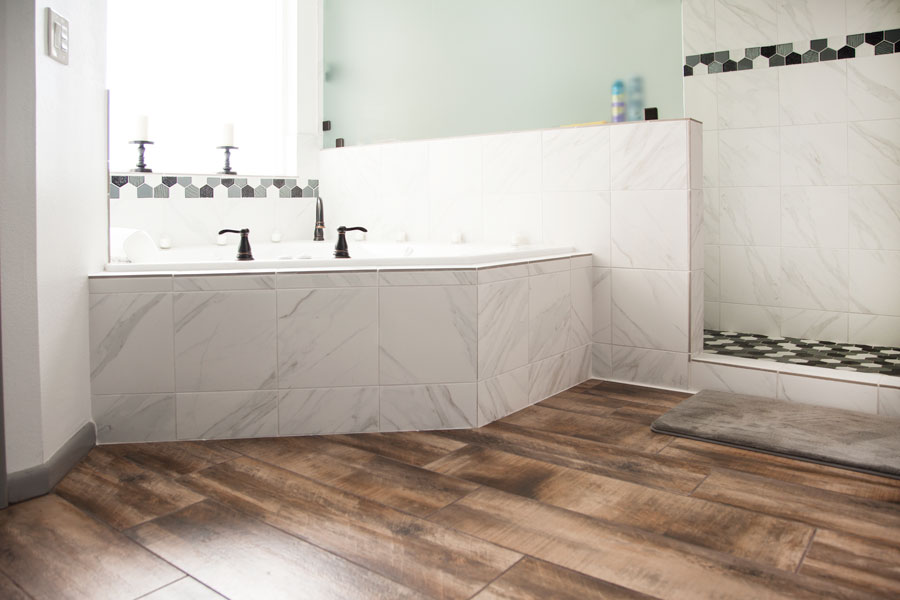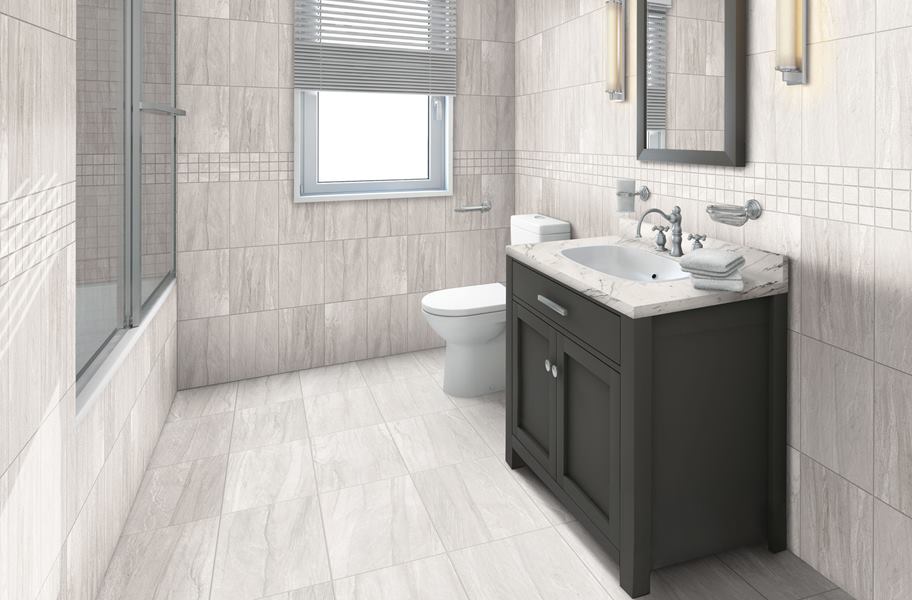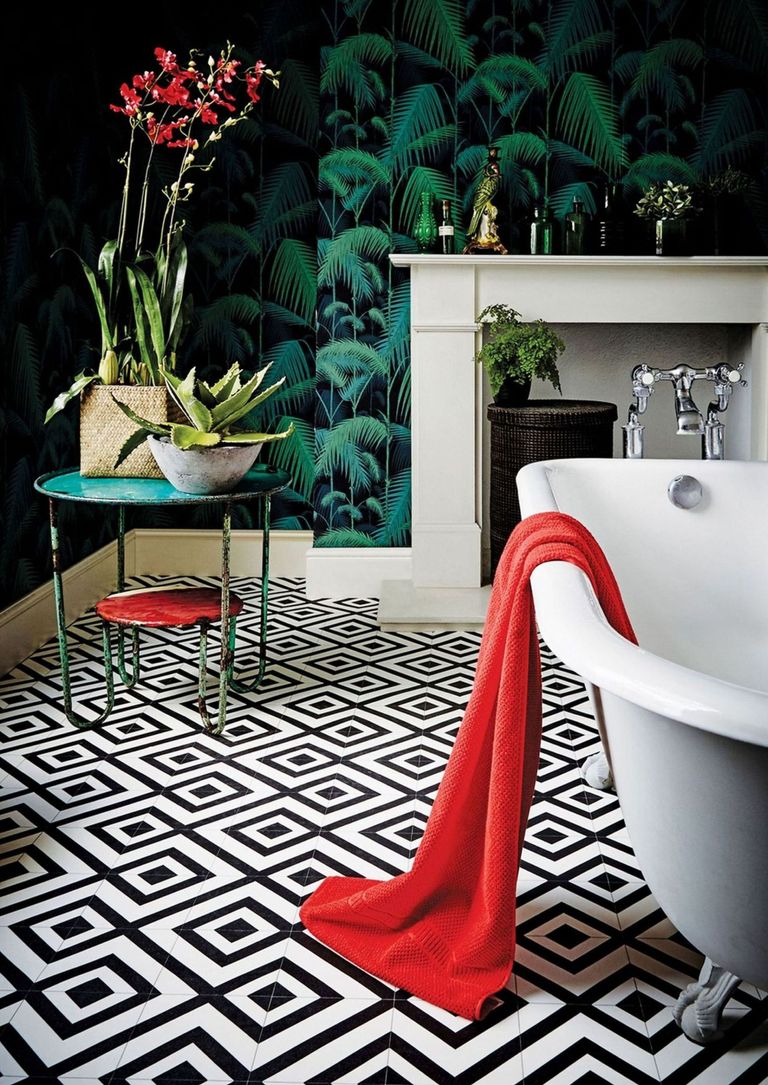The Practicality of Various Floor Coverings
When it comes to choosing the best floor covering for your bathroom, practicality should be at the top of your list of considerations. After all, the bathroom is a high-traffic area that is constantly exposed to moisture, humidity, and spills. Here are some practical aspects to consider when evaluating different floor coverings for your bathroom:
- Water Resistance: One of the most critical factors to consider in a bathroom floor covering is its ability to withstand moisture and water exposure. Look for materials that are naturally water-resistant or can be treated to repel water, such as porcelain tile, ceramic tile, vinyl plank flooring, or luxury vinyl tile (LVT). These materials are less susceptible to water damage and are easy to clean and maintain in a wet environment.
- Slip Resistance: Safety should be a top priority in the bathroom, where slippery surfaces can lead to accidents and injuries. Choose floor coverings with textured or non-slip finishes to provide traction and prevent slips and falls, especially in areas prone to splashes and spills like the shower or bathtub. Look for materials with a high coefficient of friction (COF) rating to ensure optimal slip resistance in wet conditions.
- Durability: The bathroom is subjected to daily wear and tear, from foot traffic to dropped toiletries and heavy furniture. Select floor coverings that are durable and resistant to scratches, dents, and damage, ensuring long-lasting performance and appearance. Materials like porcelain tile, ceramic tile, natural stone, and engineered hardwood are known for their durability and ability to withstand the rigors of daily use in the bathroom.
- Ease of Maintenance: Cleaning and maintaining the bathroom floor should be hassle-free and straightforward. Choose floor coverings that are easy to clean and resistant to stains, mold, and mildew. Non-porous materials like porcelain tile, ceramic tile, and vinyl flooring are effortless to wipe down and sanitize, requiring minimal maintenance to keep them looking fresh and clean.
- Temperature Resistance: The bathroom can experience fluctuating temperatures and humidity levels throughout the day, which can affect the performance and longevity of certain floor coverings. Select materials that are resistant to temperature changes and can withstand exposure to heat and cold without warping, shrinking, or expanding. Avoid materials like solid hardwood or laminate flooring, which are prone to damage from moisture and temperature fluctuations.
- Sound Absorption: In a shared or multi-story home, noise transmission can be a concern, especially in bathrooms located above living spaces or bedrooms. Choose floor coverings that provide sound insulation and absorb impact noise, reducing sound transfer and creating a quieter and more comfortable environment. Materials like cork flooring or rubber flooring offer excellent sound absorption properties, making them ideal choices for noise-sensitive areas.

Durability and Water Resistance: Key Considerations
When it comes to bathroom flooring, durability, and water resistance are paramount considerations. The bathroom is a high-moisture environment, prone to spills, splashes, and humidity, which can take a toll on certain flooring materials. Here are key considerations to keep in mind when evaluating the durability and water resistance of different floor coverings for your bathroom:
Porcelain Tile: Porcelain tile is one of the most durable and water-resistant flooring options available for bathrooms. Made from dense clay fired at high temperatures, porcelain tile is highly resistant to water, stains, scratches, and wear. It’s an ideal choice for high-traffic areas like the bathroom, offering long-lasting performance and low maintenance requirements.
Ceramic Tile: Similar to porcelain tile, ceramic tile is another excellent choice for bathroom flooring due to its durability and water resistance. Ceramic tile is made from clay and other natural materials, glazed, and fired to create a hard, dense surface that can withstand moisture and heavy use. It comes in a wide range of colors, patterns, and textures, allowing for endless design possibilities in the bathroom.
Vinyl Flooring: Vinyl flooring, including luxury vinyl tile (LVT) and vinyl plank flooring, is a popular choice for bathrooms due to its affordability, durability, and water resistance. Vinyl flooring is made from synthetic materials that are impervious to water, making it ideal for wet areas like the bathroom. It’s available in a variety of styles and designs, including realistic wood and stone looks, allowing you to achieve the desired aesthetic without sacrificing performance.
Natural Stone: Natural stone, such as marble, granite, limestone, and slate, adds a luxurious and timeless appeal to bathroom floors. While natural stone is durable and water-resistant when properly sealed, it requires regular maintenance to prevent staining, etching, and damage from moisture. Sealing natural stone periodically helps protect the surface and maintain its beauty and integrity in a wet environment.
Engineered Hardwood: Engineered hardwood flooring offers the beauty of real wood with enhanced durability and water resistance, thanks to its layered construction. Unlike solid hardwood, which is susceptible to moisture damage, engineered hardwood features a stable plywood core topped with a hardwood veneer or wear layer. This construction provides greater resistance to moisture and temperature fluctuations, making it suitable for bathrooms with proper installation and maintenance.
Laminate Flooring: Laminate flooring is an affordable and versatile option for bathroom floors, offering durability and water resistance in a wide range of styles and designs. Laminate consists of a fiberboard core topped with a photographic layer and a protective wear layer, providing a realistic wood or tile look with enhanced durability and ease of maintenance. However, laminate can be prone to water damage if exposed to excessive moisture, so it’s essential to wipe up spills promptly and avoid installing them in areas prone to standing water.
Finding the Right Look for Your Bathroom
In addition to practical considerations like durability and water resistance, the style and aesthetic appeal of your bathroom floor covering play a significant role in the overall design and ambiance of the space. Whether you prefer a sleek and modern look or a classic and timeless style, there are countless options to suit your taste and preferences. Here are some factors to consider when choosing the right look for your bathroom floor:
Tile Patterns and Layouts: Tile flooring offers endless design possibilities with a variety of patterns, layouts, and colors to choose from. Consider options like subway tile, herringbone, basket weave, or chevron patterns to add visual interest and texture to your bathroom floor. Experiment with different layouts, such as diagonal or offset patterns, to create a unique and personalized look that complements your overall design aesthetic.
Color Palette: The color of your bathroom floor covering sets the tone for the entire space, influencing the mood and ambiance of the room. Choose colors that reflect your style and preferences, whether you prefer neutral tones for a calming and spa-like atmosphere or bold hues for a vibrant and energetic feel. Consider coordinating the floor color with other elements in the bathroom, such as wall paint, cabinetry, and fixtures, to create a cohesive and harmonious design scheme.
Material Selection: The material of your bathroom floor covering plays a significant role in defining the style and character of the space. Opt for materials like porcelain tile, ceramic tile, or natural stone for a classic and timeless look, or choose vinyl flooring or laminate for a more contemporary and budget-friendly option. Each material offers unique textures, finishes, and visual effects that can enhance the overall design aesthetic of your bathroom.
Finish and Texture: The finish and texture of your bathroom floor covering contribute to its visual appeal and tactile experience. Choose finishes like matte, gloss, or textured for different effects, from sleek and polished to rustic and weathered. Consider textured surfaces for added slip resistance and visual interest, especially in wet areas like the shower or bathtub. Experiment with contrasting finishes and textures to create depth and dimension in your bathroom floor design.
Pattern and Design: Incorporating patterned or decorative tiles into your bathroom floor design can add personality and charm to the space. Consider options like mosaic tiles, geometric patterns, or intricate motifs to create focal points and visual accents on the floor. Mix and match different tile styles, shapes, and colors to create a custom look that reflects your style and taste.
Transition and Continuity: When selecting a floor covering for your bathroom, consider how it will transition and connect with adjacent spaces for a seamless and cohesive flow throughout your home. Choose materials and colors that complement the flooring in adjoining rooms, creating visual continuity and harmony between different areas. Pay attention to transition strips, thresholds, and borders to ensure a smooth and cohesive transition between flooring surfaces.
Maintenance and Cleaning for Different Flooring Options
Maintaining a clean and hygienic bathroom is essential for the health and well-being of your household. When selecting a floor covering for your bathroom, it’s crucial to consider its maintenance and cleaning requirements to ensure that it stays fresh and beautiful for years to come. Here’s a closer look at the ease of care for different flooring options:
Porcelain Tile and Ceramic Tile: Porcelain tile and ceramic tile are among the easiest floor coverings to clean and maintain in the bathroom. Both materials are non-porous and resistant to moisture, stains, and bacteria, making them easy to wipe down and sanitize with a damp cloth or mop. Regular sweeping or vacuuming helps remove dirt and debris from the surface, while periodic deep cleaning with a mild detergent or tile cleaner keeps the tiles looking their best.
Vinyl Flooring: Vinyl flooring, including luxury vinyl tile (LVT) and vinyl plank flooring, is known for its low maintenance requirements and easy cleaning. Vinyl is naturally resistant to water and stains, making it effortless to wipe down and sanitize with a damp mop or gentle cleanser. Unlike natural materials like hardwood or stone, vinyl flooring does not require sealing or special treatments to maintain its appearance, making it a hassle-free option for busy households.
Natural Stone: Natural stone, such as marble, granite, limestone, and slate, adds a touch of luxury and elegance to bathroom floors but requires more maintenance to keep it looking its best. Stone is porous and prone to staining and etching from spills, so it’s essential to seal the surface regularly to protect against moisture and stains. Cleaning stone floors with a pH-neutral stone cleaner and avoiding harsh chemicals helps preserve their natural beauty and integrity over time.
Engineered Hardwood: Engineered hardwood flooring offers the warmth and beauty of real wood with enhanced durability and water resistance, but it requires special care to maintain its appearance in the bathroom. Avoid excessive moisture and standing water, as it can cause warping, cupping, and damage to the wood. Clean spills promptly and avoid using abrasive or acidic cleaners that can scratch or dull the surface. Periodically reapply a water-resistant finish or sealant to protect the wood and maintain its luster.
Laminate Flooring: Laminate flooring is known for its easy maintenance and hassle-free cleaning, making it a popular choice for bathrooms. Laminate is resistant to water and stains, allowing for quick and easy cleanup with a damp mop or sponge. Avoid using excessive water or harsh cleaners that can damage the laminate surface, and wipe up spills promptly to prevent moisture from seeping into the seams. With regular sweeping and occasional deep cleaning, laminate flooring can maintain its appearance and durability for years to come.
Carpeting: While carpeting is not typically recommended for bathrooms due to its poor water resistance and hygiene concerns, some homeowners may choose to incorporate area rugs or carpet tiles for added comfort and warmth. If using carpeting in the bathroom, opt for moisture-resistant materials and treat them with a stain-resistant finish to protect against spills and stains. Regular vacuuming and professional steam cleaning help remove dirt, allergens, and bacteria from the carpet fibers, keeping the bathroom clean and hygienic.
Budget-Friendly Choices: Balancing Cost and Quality
When it comes to renovating or updating your bathroom, flooring is one of the most significant investments you’ll make. While there are countless options available, it’s essential to find a floor covering that not only meets your design preferences and practical needs but also fits within your budget. Here are some budget-friendly choices for bathroom flooring that offer a balance of cost and quality:
Vinyl Flooring: Vinyl flooring is one of the most affordable options for bathroom floors, offering excellent value for money without sacrificing style or performance. Vinyl comes in a variety of styles and designs, including luxury vinyl tile (LVT) and vinyl plank flooring, mimicking the look of natural materials like wood, stone, and tile at a fraction of the cost. It’s easy to install, durable, and resistant to water, stains, and scratches, making it a practical and budget-friendly choice for any bathroom.
Laminate Flooring: Laminate flooring is another cost-effective option for bathroom floors, providing the look of real wood or tile without the high price tag. Laminate consists of multiple layers of synthetic materials, including a photographic layer that replicates the look of natural materials and a protective wear layer that enhances durability and resistance to wear and tear. With its easy installation, low maintenance requirements, and budget-friendly price point, laminate flooring is an excellent choice for homeowners on a budget.
Ceramic Tile: Ceramic tile is a versatile and budget-friendly option for bathroom floors, offering durability, water resistance, and endless design possibilities at an affordable price. Ceramic tile comes in a wide range of colors, patterns, and textures to suit any style or aesthetic preference, from classic to contemporary. While the cost of ceramic tile may vary depending on factors like size, quality, and design, it remains an accessible and economical choice for budget-conscious homeowners.
Engineered Hardwood: Engineered hardwood flooring provides the beauty of real wood with enhanced durability and water resistance, making it a cost-effective alternative to solid hardwood for bathroom floors. Engineered hardwood consists of multiple layers of wood veneer bonded together with adhesive, creating a stable and moisture-resistant surface that can withstand the rigors of daily use in the bathroom. While engineered hardwood may be slightly more expensive than vinyl or laminate, it offers the timeless appeal of wood with added durability and longevity.
Carpet Tiles: For homeowners seeking a budget-friendly and customizable option for bathroom floors, carpet tiles offer an affordable and versatile solution. Carpet tiles come in a variety of colors, patterns, and textures, allowing you to mix and match tiles to create custom designs and layouts. They are easy to install, remove, and replace, making them ideal for DIY projects and temporary flooring solutions. While carpet tiles may not be suitable for wet areas like the shower or bathtub, they can add warmth and comfort to dry areas of the bathroom at a fraction of the cost of traditional carpeting.
Sheet Vinyl: Sheet vinyl flooring is a budget-friendly and practical choice for bathrooms, offering seamless installation, water resistance, and easy maintenance at an affordable price point. Sheet vinyl comes in large rolls that can be cut to size and installed without seams, creating a smooth and continuous surface that is resistant to water and stains. With its wide range of colors, patterns, and textures, sheet vinyl allows you to achieve the look of tile, stone, or wood at a fraction of the cost and effort.
Best Bathroom Flooring Options – Flooring Inc
Tile Options for the Bathroom Floor
Bathroom flooring idea
What is the Best Flooring for Bathrooms?
Bathroom Floor Tiles: Options for Your New Bathroom Floor
Floor Tiles – Our Pick of the Best Ideal Home Bathroom floor
Related Posts:







